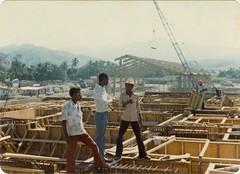In 1982 there was a recession, especially in the building industry. In order to stem the inflation that had plagued the Ford and Carter years (some say it was caused by the expenditures during the Vietnam era) the Reagan administration tightened lending rates, and the construction industry seemed to crash almost overnight that spring. And as usual, when the rest of the county gets a cold, the Keys got pnemonia.
That spring I got laid off, moved all my wordly possessions to an aluminum storage shed behind my girlfriend's parents' house in Key West, and started to draw unemployment checks, pondering my next move. One afternoon we went to Key West Bight, hoping to buy a fish off of one of the charter boats for a reasonable price, when we ran into Mary White O'Brien, who was working as an agent for Gray Taxidermy out of Fort Lauderdale.
She said her husband, Jim, who was one of my best friends, was trying to get in touch with me. The previous March Jim had gone to Haiti with Doug Gaines, an engineer who had had a construction business in Marathon for many years, on what seemed to me to be some sort of quixotic jaunt. Both of them were men who were known to end up in odd places--not your ususal run-of-the-mill individuals, for sure.
I called Jim at the number in Haiti that Mary had given me. Within a few days I was walking onto the steaming tarmac at Francois Duvalier Airport in Port-au-Prince, the beginning of a most intense couple of years. A small group of Americans, along with a great number of Haitian workmen, was about to construct a new sugar mill in Haiti.
Jim's theory was that a cartel was trying to corner the world sugar market. This was just before the introduction of "high fructose corn syrup," which replaced cane sugar as the primary sweetener in soft drinks (remember the "New Coke"?), a development that possibly thwarted their plans.
The American Consulate's economic attache thought that the idea of building a new sugar mill was absurd. He said that diversified production of foodstuffs on small family plots was the key to Haiti's survival.
We found out later that the Haitians had a "scam" they ran every so often, of building a new sugar mill with foreign money. Whether they produced any sugar or not was irrelevant. In fact, every day as we drove to the jobsite, we passed an unfinished, abandoned, sugar mill that the Cubans had begun twenty years before.
We also learned that the equipment for the mill that we were building had been sold to Uganda, when it was under the control of "Big Daddy" Amin, the dictator whom the Israelis out-foxed in the famous Entebbe raid, and who was later deposed. The Italian company who had made the now obsolescent equipment arranged through European banks to sell it to a third party, in this case the Haitian government, in exchange for a 10 year participation in the anticipated profits.
In the next segment: We hire a bunch of workers, the Job begins, and a surprise visit from Baby Doc.
An Update
-
This is Bob's daughter, Susan. In case there are still some visitors
following his blog, I wanted to share the sad news that our Dad passed away
on April 1...
3 years ago




No comments:
Post a Comment